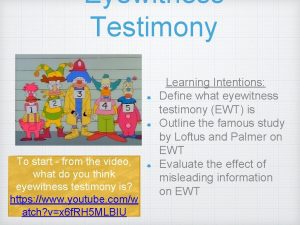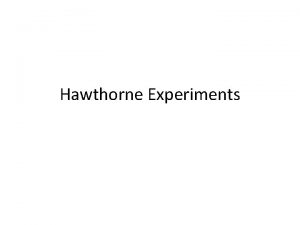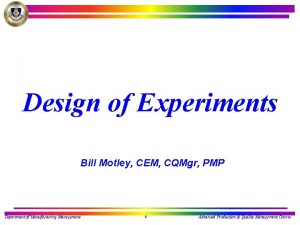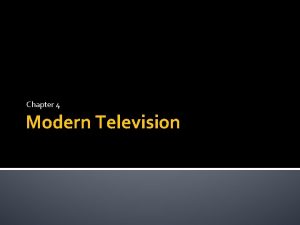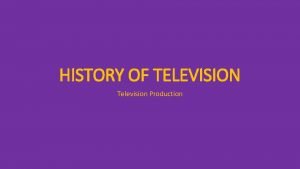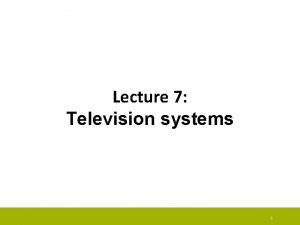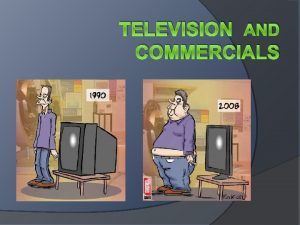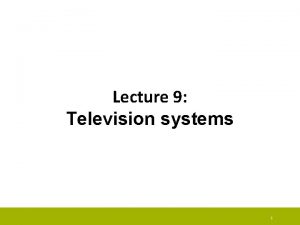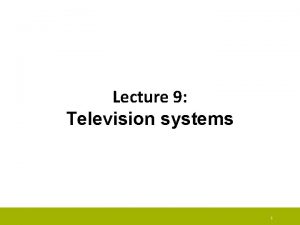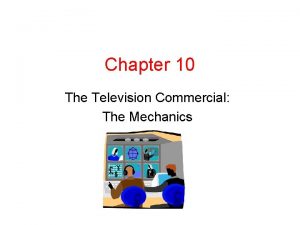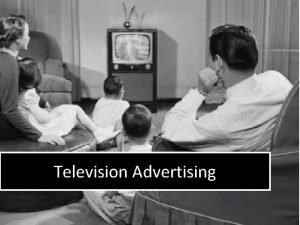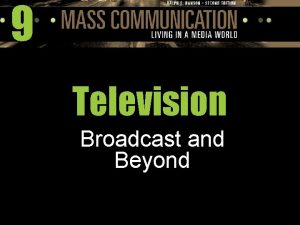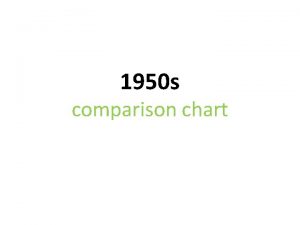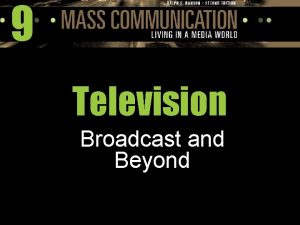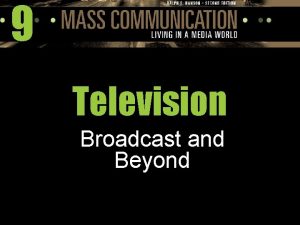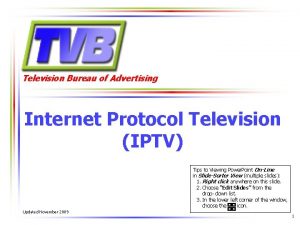Chapter 3 Early Television Early Experiments Early television


























- Slides: 26

Chapter 3 Early Television

Early Experiments Early television was very different than today Mechanical scanning – 1 st TV’s Electronic scanning – Adopted system ▪ How modern television received its start ▪ (Breaking images into tiny points of light for transmission over radio waves), ▪ Video ▪ Additional TV History

Early Experiments David Sarnoff built one of the 1 st stations in 1932, ▪ With transmitting facilities in the Empire State Building, and a million dollars spent promoting the medium. FDR became the first president to appear on television ▪ He formally opened the 1939 World’s Fair in New York. Early TV sets did not sell because ▪ They were very expensive, ▪ There wasn’t much programming, ▪ There were no technical standards.

A Brief History of Television Development of Technical Standards Manufacturers wanted the profits if their patents became the broadcast standard. ▪ Some wanted black & white technology ▪ Others worked on color & wanted to wait for it to be perfected. Other patents involved lines of resolution/pixels, That make up the picture image. 60 lines, then 441 lines In 1941, government & industry agreed on television standard ▪ Black and white pictures with 525 lines of resolution ▪ Recommended by (NTSC) ▪ National Television System Committee What is the line resolution for HD TV

Emergence of Broadcast TV With color being debated In 1947 FCC felt color would be hardship on consumers ▪ They would have to buy a news set Television emerged as a mass medium in 1948 ▪ Stations, sets & audience increases 4000+ % ▪ Advertisers took notice Networks ▪ TV networks existed prior to 1948 ▪ As offshoots of radio ▪ NBC, CBS, ABC…. . & Du. Mont (for a while)

A Brief History of Television The Rise of Network Television At first there were four television networks: ▪ NBC, CBS, ABC and Dumont, a network founded by TV manufacturer Allen B. Dumont ▪ He got into production to increase demand for his sets. Dumont lacked the radio relationships of the others ▪ Could not line up enough affiliates to be attractive to advertisers. ▪ Dumont folded in 1955. ▪ Its stations became the nucleus of Metromedia Television, ▪ which eventually became the Fox network.

The Freeze Television was growing rapidly In Fall 1948 FCC imposed a Freeze ▪ To stop interference between stations ▪ Freeze lasted 4 years ▪ Ended with FCC assigning channels to different areas of U. S. ▪ FCC realized 12 stations weren’t enough UHF began What is UHF

The Freeze Enter Cable television began in the 1950 s as “Community Antenna Television” (CATV). ▪ Designed to give hard-to-reach areas reception from broadcast TV stations. The earliest CATV pioneers were appliance dealers who hoped to sell TV sets. ▪ They would install a large antenna on a nearby hilltop ▪ Amplify the local station signals that were received, ▪ Then distribute them to the community by means of a cable. CATV became cable television in the 1970 s ▪ When it began to offer additional signals from distant stations, a service called importation.

Early TV Programming I Love Lucy Introduced process of prerecording films ▪ Then broadcasting them later ▪ Other shows aired live Television Newscasts – Video Developed slowly in the 1950’s ▪ Early newscasts lacked footage ▪ Due to expense of crews/equipment ▪ Deals with newsreel companies provided early footage

Early TV Programming Television’s Golden Age 1948 to 1958 was a time of good dramatic programming. Quality dramas were needed to attract wealthy, educated viewers who could afford television sets. Network programming originated in New York City ▪ Producers had access to up-and-coming Broadway writers, actors, and directors. Most television dramas were performed live ▪ Videotape recording had not been invented yet, ▪ Filming was too expensive.

The Live Era 1950’s programming ▪ Predominately live Several programs jumped to film ▪ To help increase potential revenue through foreign broadcast systems ▪ New formats were introduced during this time ▪ Spectaculars – shows outside of the regular schedule ▪ Today & tonight shows – Hosted interview based shows ▪ Concept of network control developed Instead of advertiser control ▪ Advertisers bought slots of time

Color TV Approval 1950 - Color TV was deemed superior ▪ FCC accepted the CBS system RCA fought the CBS system ▪ Refused to program in color ▪ Improved their own system ▪ One approval for their system by NTSC in 1954 ▪ CBS also accepted RCA system Color sets became cheaper, programming increased ▪ More consumers adopted ▪ By 1960, networks & most stations produced in color

Broadcast-Cable Clashes As cable became more sophisticated ▪ Wiring & connections improved ▪ Stations were imported from distant cities ▪ Broadcasters complained ▪ About audiences lost to imported stations ▪ Less revenue from decreased advertising values FCC applied non-intervention policy ▪ Left decision to courts ▪ It didn’t work

The Quiz Scandals Game shows became popular in the 1950’s ▪ $64, 000 questions was one of the best Twenty-One broke game show scandals wide open. ▪ Contestants in isolation booths were given a categories ▪ Charles Van Doren an English instructor at Columbia University about playing Twenty-One. Assistance was given to add "entertainment value" of the show. Led to amendment of Comm. Act ▪ Making it unlawful to help contestants

UHF & Cable TV Problems One of the first FCC rules for cable ▪ Could not duplicate network programs on the same day that the network aired them. Another important regulation known as must carry rules, ▪ Which said that cable systems had to carry all local televisions stations within each system’s area of coverage. Cable’s big growth period was between 1970 and 1990 ▪ (10 percent of homes wired) to (60 percent of homes wired). Today’s cable systems carry hundreds of channels. ▪ List some of the biggest/best known cable channels © 2008 The Mc. Graw-Hill Companies, Inc. All rights reserved

UHF & Cable TV Problems The Cable Industry Today’s cable operations are run almost exclusively by multiple system operators (MSOs), ▪ Which are companies that own several local cable service providers, in different areas of the country. ▪ MSOs are generally owned by giant communications corporations like Time-Warner or Comcast. ▪ Are there any other cable companies you can think of? © 2008 The Mc. Graw-Hill Companies, Inc. All rights reserved

Early Cable TV Programming Early Cable Programming Simply providing existing channels to remote areas ▪ Charging install & monthly fees ▪ Eventually provided some self produced basic programming ▪ Weather ▪ News Most municipalities require MSO’s to provide access channels ▪ Which are open to the general public on a first come, first served basis. ▪ Public Access Channels

Reflections of Upheaval Television News After WW II TV executives believed people would still rely on radio news, ▪ TV would be used as an entertainment medium. ▪ Edward Murrow at CBS believed otherwise. TV news had difficulty getting footage until deals were made with newsreel companies © 2008 The Mc. Graw-Hill Companies, Inc. All rights reserved

Reflections of Upheaval By the early 1950 s the television networks were maintaining film crews in important locations ▪ Relying on stringers (Freelancers) in other places. ▪ Film, however, remained expensive to process. TV still relied on newsreel-type footage until the 60’s ▪ News in places where film crews were not at wouldn’t be covered. By the mid 1970 s, videotape, which required no processing, ▪ Freed television news from its reliance on film. © 2008 The Mc. Graw-Hill Companies, Inc. All rights reserved

Reflections of Upheaval Coverage of Assassinations and Civil Unrest Kennedy assassination marked the beginning of a turbulent decade ▪ The 1968 assassinations of ▪ Robert Kennedy and Martin Luther King, ▪ A number of urban riots that were sparked by protests against racial discrimination and the Vietnam War. ▪ 1965 Watts Riots © 2008 The Mc. Graw-Hill Companies, Inc. All rights reserved

Reflections of Upheaval Coverage of Vietnam Eventually, in-depth on-the-scene TV reporting from the Vietnamese battlefield ▪ Began to include bloody footage of young soldiers being maimed and killed. This created a credibility gap between Govt attempts to manage the news and what the public believed to be true. ▪ Are you more likely to believe what you hear or what you see © 2008 The Mc. Graw-Hill Companies, Inc. All rights reserved

Public Broadcasting Act of 1967 By 1966, the networks were broadcasting all their prime-time shows in color ▪ People were rushing out to replace their old black-and-white sets. Public television was established in 1967. ▪ PBS Television’s economic golden age is thought to have occurred ▪ From 1960 and 1980 ▪ When the big 3 networks had few competitors in the industry or outside it. Independent stations began to compete a little, but the real challenger to network television was cable TV. © 2008 The Mc. Graw-Hill Companies, Inc. All rights reserved

Public Broadcasting Act of 1967 Television Changes Family Life Classic children’s shows included ▪ “Bozo the Clown”, “Romper Room”, & “Sesame Street. ” ▪ What are some current children’s shows on TV “Wide World of Sports” is a classic sports program. Classic programs are regularly scheduled, long- running prime-time entertainment programs ▪ That changed what people talked about over coffee the next day.

Corporate Video Introduced in the 60’s & 70’s Included use of TV equipment by ▪ Corporations, educational institutions, Govt. , & non-profits ▪ Primarily used to train/teach ▪ Employees ▪ Students ▪ Businesses also developed (CCTV) ▪ Closed circuit TV – Wired & broadcast throughout a building Specialized college broadcasts ▪ Evolved into distance learning & teleconferencing

HBO’s Influence Premium Cable Premium cable channels such as Home Box Office (HBO), Showtime, and Cinemax ▪ Provide programming to cable subscribers for an additional fee, above what they pay for basic cable. ▪ A converter, or cable box, unscrambles the signals for premium cable. Pay-per-view channels ▪ Allow customers to order recent feature films, sporting events, concerts, an other special events on a set schedule. ▪ How many of you watch premium channels regularly ▪ What type of programming do you watch

HBO’s Influence Superstations The first superstation, a local station delivered to cable systems via satellite, ▪ Created in 1976 when Ted Turner sent the signals of WTBS, his Atlanta UHF station, for distribution throughout the country. Turner raised advertising rates ▪ Turned what had been the lowest-rated station in Atlanta into a financial success.
 Chapter 13 experiments and observational studies
Chapter 13 experiments and observational studies Chapter 2 american experiments summary
Chapter 2 american experiments summary Http://earthobservatory.nasa.gov/experiments/biome/
Http://earthobservatory.nasa.gov/experiments/biome/ Test your hypothesis
Test your hypothesis Survey vs observational study
Survey vs observational study Jean piaget 1896 a 1980
Jean piaget 1896 a 1980 Counting rules probability
Counting rules probability Balanced outlook on law
Balanced outlook on law Science experiments for highschool
Science experiments for highschool Eyewitness testimony video experiments
Eyewitness testimony video experiments Computer science experiments
Computer science experiments Czech experiments
Czech experiments Griffith 1928
Griffith 1928 Design of experiments doe
Design of experiments doe In his transformation experiments what did griffith observe
In his transformation experiments what did griffith observe Which three criteria do binomial experiments meet?
Which three criteria do binomial experiments meet? Jmp design of experiments
Jmp design of experiments Survey experiment or observational study
Survey experiment or observational study Examples of binomial experiments
Examples of binomial experiments Iit kharagpur virtual lab computer organization
Iit kharagpur virtual lab computer organization Francis cecil sumner, ph.d.
Francis cecil sumner, ph.d. Twins separated at birth nature vs nurture
Twins separated at birth nature vs nurture Sample construction portfolio leaving cert
Sample construction portfolio leaving cert Core flooding experiment
Core flooding experiment Mass interviewing programme
Mass interviewing programme Design of experiments six sigma
Design of experiments six sigma Design of experiments pmp example
Design of experiments pmp example









